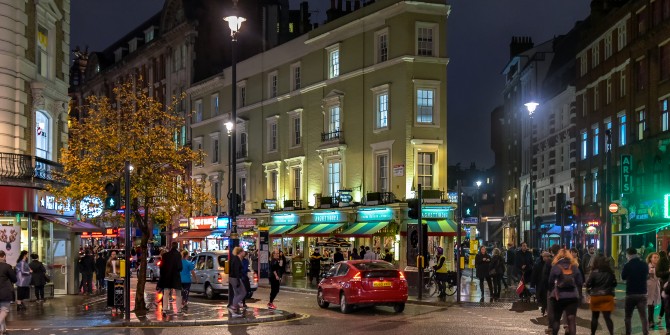The notion of the 15-minute city, in which people can work, shop, play and go to school within a small radius of their home, has attracted some urban planners. But now more than ever, argues Edward Glaeser (Harvard), it should be recognised as a dead end which would stop cities from fulfilling their true role as engines of opportunity.
Aspects of the 15-minute city are praiseworthy. I yield to no one in my embrace of the pedestrian city. I have long believed that walking as the best of all possible modes.
I also believe that cities should be freed from the business regulations that make it difficult to start small shops and cosy cafes in residential neighbourhoods. An exciting mixed-use neighbourhood can be one of the best gifts of urban entrepreneurship. In the US, we regulate the entrepreneurship of the poor far more than we regular the entrepreneurship of the rich. The rich innovate in cyberspace, which is largely a regulation free zone. The poor innovate on the ground, in real things, and local government rules micromanage the physical.
But the basic concept of a 15-minute city is not really a city at all. It’s an enclave — a ghetto – a subdivision. All cities should be archipelagos of neighbourhoods, but these neighbourhoods must be connected. Cities should be machines for connecting humans – rich and poor, black and white, young and old. Otherwise, they fail in their most basic mission and they fail to be places of opportunity.
While modern American cities are engines of opportunity for adults, they are dead ends for children. Adults who come to the city – rich and poor alike – see their wages rise as they spending more time there. But as Raj Chetty’s work on upward mobility has shown, children who grow up in cities end up doing much worse as adults than children who grew up outside them. One explanation for this difference is that an adult doesn’t live in a 15-minute city. A lower income adult may wake up in her tenement apartment, but then she goes to her job somewhere else. She finds opportunity with people who are wealthier and better educated. The child, however, lives in a 15-minute city. Perhaps, he wakes in a low-income housing project and then goes to a highly segregated school. That child live in a 15-minute city that is no more integrated than a poor rural village. In that world, the rich have isolated themselves from the poor, and the poor are cut off.
The view that we can duplicate real movement with virtual movement is a fantasy for less well-educated people. In May 2020, 70% of Americans were doing their work virtually, but only 5% of Americans without a high school degree were telecommuting. If we allow this virtual world to persist, our world is going to become even more catastrophically unequal.
The view that we are improving accessibility for everyone by enabling people to work virtually is completely wrong
We should embrace the good aspects of the 15-minute city— the idea of accessibility, perhaps driving less, and embracing congestion pricing — ultimately, we should bury the idea of a city that is chopped up into 15-minute bits. Post-COVID, we must embrace the idea of the whole city that is connected with the whole of our metropole and with the whole of the world. Ultimately, we should learnt from this terrible pandemic that all of us are in this together. We must ensure this never happens again, and we must particular enable those people who start with less to connect to the rest of the city.
Transport is beginning to change
The rise of autonomous vehicles and technologies like hyperloop may make a major difference to the way we travel around cities. I’m 54, and the transportation I take is not very different from the kind I took 50 years ago. After a very slow period of change, it now makes sense to keep flexibility to allow the future to catch up with us. It makes sense to keep our options open so that our cities can embrace the new technologies as they come along. And as they come along, don’t embrace the new, new thing uncritically. The right approach is to experiment, evaluate, and use the wisdom that comes with experience.
Who pays for it?
The principle that the user should pay is generally right, particularly for anything involving middle-income or wealthy people. Subsidising people to fly in and out of JFK airport with tax dollars is an absolutely terrible idea.
In a sense, COVID has been an attack on our urban life
But sometimes, because the marginal cost to provide the service for extra traveller is so much lower than the average cost (as in the case of some rail trips), it makes sense to figure out creative ways so that users can fund it, without deterring efficient use of the system. My favourite example is Hong Kong’s MTR model, where they built large-scale real estate development on top of train stations. Effectively the real estate subsidises the rail, which is a beautiful way of keeping the rail price low while still having the users pay for things.
Nonetheless, in some cases it is unrealistic to expect users to pay. We will often want to subsidise services to get poorer people to their jobs or to care for their parents.

A related challenge in the developing world is that you often have two technologies coexisting — one a technology for the rich, the other a technology for the poor. For example, in Johannesburg you have the Gautrain, a fast, modern rail service coexisting with crowded minibuses that are often unsafe. Oddly, it is typically the transportation that the rich uses that is subsidised. The transportation for the poor pays for itself.
Going forward, should you be trying to make the rich technology available to everyone, or should you be trying to upgrade the current, poor technology? Given that the minibuses are self-financing and better targeted to serve the least fortunate, you should probably focus on the improving the minibuses. Certainly, it makes sense to ensure that the minibuses become safer, have a clear schedule and work seamlessly with other modes.
The need for congestion pricing
There is no substitute for doing something that functionally taxes carbon. You can’t just subsidise alternative uses of transportation and hope that it will work out. You need to do something that actually limits people’s incentive to fly or drive, and that requires a tool like congestion pricing. Using general tax revenues to pay for highways or having free parking is unjustifiable essentially subsidises climate change.
The genius of Ken Livingstone’s London congestion charge was that it used its revenues, paid by wealthier drivers, to pay for poorer people who were taking the bus. Done right, congestion pricing means that rich people pay to make commutes faster and more comfortable for the poor. In some places, the pandemic has made road congestion much worse because people are afraid to use public transport. That only increases the urgency of adopting congestion pricing wherever possible.
In a sense, COVID has been an attack on our urban life. It has reminded us that while cities enable us to share, to connect, and to learn from one another, density also comes with considerable downsides, and the most terrible of these is contagious disease. We have had a blessed century of plague-free existence since the 1918/19 influenza pandemic, and COVID-19 has not been nearly as bad as it could have been.
But let us make sure that our governments heed this warning. We must make major investments in public health — a NATO for public health, rather than the WHO — and that’s only the first and most important step to reclaim the streets. There’s no sure-fire recipe for fixing our car-crowded roadways, but a healthy embrace of congestion pricing is clearly a good place to start.
The view that we are improving accessibility for everyone by enabling people to work virtually is completely wrong. If it is only possible for people to access jobs through the internet, then we are locking out the third of the American population that is unable to do that. I cannot imagine a more unequal world than one which has eliminated real, urban face-to-face connections and tried to replace them with virtual links.
Our discussions and spending on urban mobility has over-emphasised the mobility of the rich. But we have largely ignored the mobility of the poor at all — especially in the US. I am very worried that a focus on enabling upper-middle-income people to walk around in their nice little 15-minute neighbourhood precludes the far larger issue of how we make sure our cities once again become places of opportunity for everyone. Enormous inequalities in cities are only tolerable if cities fulfill their historic mission of turning poor people into rich people. I am only interested in urban planning concepts that fundamentally solve that problem, and the 15-minute city seems likely to make that problem even worse.
This post represents the views of the author and not those of the COVID-19 blog, nor LSE. It is based on Edward Glaeser’s contribution to Localising Transport: Towards the 15-minute city or the one-hour metropolis?, an event hosted by LSE Cities, the Alfred Herrhausen Gesellschaft and the LSE School of Public Policy, and supported by SAP SE and knowledge partner Teralytics.



I wonder whether the 15 minute city concept isn’t taken too literally. I have understood it only enhances the best liveable qualities of successful cities. London for instance. One ‘village’ has all the daily needs for ordinary people, primary and secondary schools, various service,surgeries, most shops, play spaces,green spaces even cultural institutions and ,of course, pubs. However, for decades, the planning prioritized long distance infrastructure(read cars) instead of local transport .London somewhat resisted and retained its original shape,rail and tube lines as well as local character and bussinesses. Now London works on local (walking and cycling) and global (e.g. new Crosslink) at the same time.So why not both enhance interconectivity and start thinking about foot and bike radiuses,orbital public transport, improving local enviroment and services too. Neither,in my opinion, is going to happen via tech like self driving vehicles or loops, which will always cost the Earth and transport few. I understand your worry about a fractioned city being unequitable and void of opportunities but I see it more from a positive angle. People on low incomes having improved services and local infrastructure might mean more life quality,health and dignity, possibly more job opportunities locally. Mind you, I have lived in London for 15 years, so coming from a very privileged experience of very diverse and non-segregated city in all senses. 15 minutes, if taken literally, would take me everywhere and anywhere but work (most of my time here) . On bike. Thanks for an interesting read. It is really great to have ones, admittedly biased, view challenged by a cohesive argument like yours. I will try to keep my eyes open.
This article is a strange misunderstanding of the 15-minute city (assuming the entire time that it means segregated neighborhoods, which it certainly does not), incorrectly cites others work (in the link to Chetty’s work he did not find that children growing up in cities were less mobile, he found that there was less mobility in the Deep South and parts of the Midwest), and confuses telecommuting with the 15-minute city. I don’t understand why economists think themselves experts on cities – especially once they are associated with elite universities. I’m surprised LSE wouldn’t vet something like this.
This is a bizarre article that fails to understand even the basic tenements of urban design, and for ‘rich, poor, black and white’ people to properly live in a place, there has to be basic amenities within walking distance, this has existed as long as people have existed (before cars) most american cities are a failure of design with housing, work, and retail/commercial separated by distances only cars can manage, forcing people on lower income to put more money into having a necessary car than anything else, this has created the low income ghettoisation of american suburbs as much as it has created the wealthy socially myopic gated communities.
Is the supermanzana concept in Barelona also a ghetto?